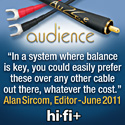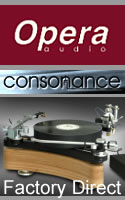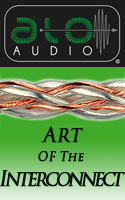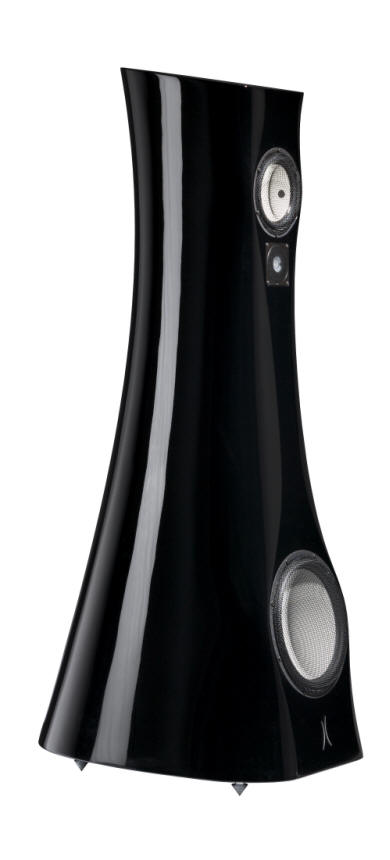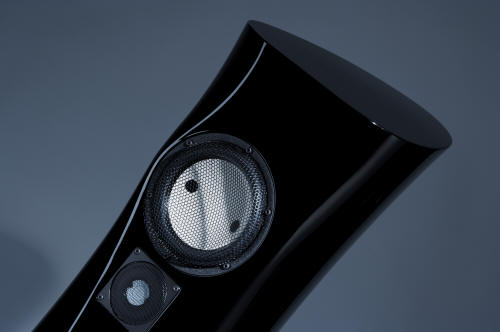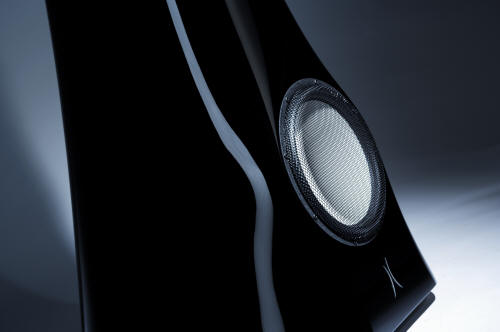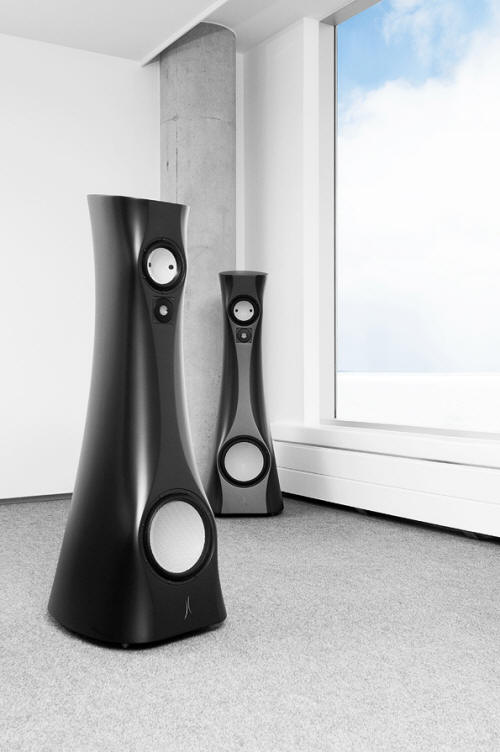|
|
You are reading the older HTML site
Positive Feedback
ISSUE
58
estelon XA Loudspeakers as reviewed by Roger Gordon
While at the Consumer Electronics Show (CES) in January 2011 I heard the Estelon XA speakers (US$43,900, three way floor standing speakers using Accuton drivers) in three different rooms. I liked the sound in all three rooms. During conversations with friends in the hallways at CES the rooms with the Estelon XAs kept being mentioned as having good sound. In June, at the Newport Beach Audio Show, the Estelon XAs were being exhibited in one of the rooms with Edge Electronics and Kubala-Sosna cabling. The sound was again very good. But, how good were the Estelon XA speakers? It is virtually impossible to form any definitive conclusion about a piece of audio equipment just by listening to it in a hotel room at an audio show. The only way to really find out is by listening to the piece of equipment in your own listening room. On the day following the Newport Beach Audio Show a large commercial van pulled into my driveway. Inside the van was Bill McIntosh, the person who oversees the sales and marketing for Alfred and Partners, the company that produces the Estelon line of speakers. Accompanying Bill was Alfred Vassilkov, the designer of the Estelon line of speakers and the Alfred in Alfred & Partners, and his daughter Alissa. In the back of the van were two large, heavy shipping crates (130 kg/286 lbs each) containing the XAs and two large, heavy boxes (55kg/120lbs) containing the Edge Electronics NL 12.2 stereo amp (US$24,388) and Edge Electronics Signature 1.2 preamp (US$14,388) that were used at the Newport show. Getting the 85kg/187lbs XAs out of their shipping crates and into position in the listening room was a very simple 15 minute task thanks to the ingenious design of the speakers and shipping crates. More on that later. With the XAs in approximately the right location and connected to my 24 watt Single Ended Triode deHavilland 845 mono block amps (1) Mr. Vassilkov listened to music and gradually walked the XAs into what he thought were the best positions in my asymmetrical listening room. Over the next five months I played hundreds and hundreds of hours of music through the XAs. I experimented with different locations for the speakers and listening position. I tried three different brands of 20 amp power cords on the Edge preamp and amp, three different brands of 15 amp power cords on sources, five different brands of interconnects, and four different brands of speaker cable. I used both the Edge amp and preamp as well as my own Herron M-1 mono block solid state amps and Herron VTSP-3A tube preamp. During the reviewing period my listening panel came over numerous times, usually bringing guests, to hear the sound of the different combinations. Right before I crated up the XAs for return shipment our local audio society, the San Diego Music and Audio Guild, held their monthly meeting at my home so that everyone could get a listen to the XAs. Virtually everyone who heard the XAs commented on the incredible bass. Many said it was the best bass that they had heard from any floor standing speaker. Other common comments were about the seamless integration of the three cone drivers, the fact that the cone midrange woofer and inverted cone tweeter sounded like they were electrostatic panels or ribbons, and that the XAs seemed to be neutral in sound. One other telling comment was their astonishment that the Accuton tweeter did not get strident or harsh which it had done in virtually every other speaker that they had heard that used the Accuton tweeter. In summary, most people who heard the Estelon XAs were impressed. So was I. Physical Details The XAs are certainly not your traditional wooden box loudspeaker. The XA cabinet is made of a non-resonating marble-based composite that is cast. If you rap on the cabinet all you get is a dull thud. There are no parallel surfaces inside the cabinet and each driver has its own separately designed enclosure. The XA speaker actually comes in two versions: the US$43,900 version being reviewed here and a US$64,000 XA Diamond. While the two speakers look very similar the only part they have in common is the woofer driver. Everything else - drivers, cabinet, crossover, etc—are completely different. The XA speakers being reviewed use an 11" Accuton ceramic sandwich dome woofer and a 7" Accuton ceramic membrane midwoofer. The tweeter is a 1.2" Accuton ceramic inverted dome. The manufacturer's specification sheet says that the speaker has:
Each speaker is delivered in its own shipping crate. Each shipping crate weighs 45kg/99lbs and looks like a footlocker with metal edging running along all edges. The crate is split into two halves like a sarcophagus. The latches that hold the two halves of the crate together are a high quality twist latch that is spring loaded so that it clicks to let you know when the latch is completely closed. The spring should also prevent the latch from opening during transit. There are two wheels built into the back bottom edge of the crate so that you don't need a dolly to move the speakers on flat surfaces. To assist you in using these wheels there are two recessed pull handles on both top and bottom surfaces that are spring loaded so that they stay tucked in their recess when not being used. You will need the help of a friend to set up the speakers. First set the crate on its back, unlatch the six latches and lift off the top half. Repeat this with the second crate. Inside each crate you will find a pair of white gloves with rubberized palm and finger surfaces. Both of you should put on these gloves. Once gloved, raise one crate to vertical and undo the velcro belt (seat belt) that is strapping the speaker into the bottom half of the crate. Now roll the speaker out of the crate. Roll? Yes, the speaker is shipped with four swivel wheels on the bottom. Remove the protective stocking that is stretched over the speaker. Roll the speaker into place in the listening room. Repeat for the second speaker. Now it is time to move the speakers around to locate the best positions for them. The swivel wheels make this very easy. Once you have determined that the speakers are in the correct position, retrieve from each crate the small wooden box that holds the speaker cone feet. While one of you tilts the speaker to one side so that the swivel wheels are an inch off of the floor, the other person pulls the two swivel wheels from their rubberized mounting holes and then screws two of the cone feet into their bolt holes. Now tilt the speaker to the other side, remove the swivel wheels and screw in the remaining two cone feet. Repeat for the second speaker. Use the provided cleaning cloth to wipe down the speakers to remove dust and/or smudges. Put the cone boxes and the swivel wheels back into their respective crate, close up the two crates, put them away in storage and you are done. As a person that has had to move 136kg/300lbs speakers this ingenious way of having the speakers on wheels is a godsend. Also, the shipping crate is much stronger than a cardboard box and the form fitted foam padding inside should protect the speakers from most falls. If you have ever experienced, as I have, the situation of watching a UPS driver shove the cardboard boxes containing your new 50kg/110lbs speakers off the end of his truck and see the boxes drop 1.83m/6' onto a concrete driveway landing on their corners (2), you will really appreciate these shipping crates. Setup Details Some speakers are very fussy about where they are located. This means the speakers have to form an exact equilateral triangle with the listening spot or the speakers have to be toed-in so that the sound from the two speakers cross in a specific point in front of or behind the listening spot, etc. The XAs are not fussy about where they are located (within reason) in the listening room. I moved the speakers back and forth trying to find the best location for them. Yes, the sound changed with each small move, but not by much. After waltzing the speakers around the room they ended up in essentially the same location as where Mr. Vassilkov had located them but with the listening spot moved 30 cm/12" forward. With the speakers properly positioned it was time to start fine-tuning the system by trying out different combinations of power cords and cabling. What I was trying to recreate was the sound that I had heard in the exhibit room at the Newport Beach Show. What had really caught my attention at Newport was the sense of the music effortlessly free flowing out of the speakers. My initial experiments with the power cords and cabling that I had on hand showed that the XAs are very transparent. Any change made upstream is readily apparent. Most of the power cord/cabling combinations I tried sounded very good. However, the sound did not have the same ease and naturalness that I remembered from the Newport show. While at the Newport show Joe Kubala of Kubala-Sosna Research Audio Cables had offered to loan me any cables or power cords that I needed for reviewing the XAs. I contacted Joe and he shipped to me essentially the same Kubala-Sosna cables and power cords that had been used at the Newport show. With Kubala-Sosna power cords and cabling throughout the system the wonderful sound that I remembered from the Newport show had returned. During the next few months I continued to experiment with different cables and power cords borrowed from local dealers. However, I always came back to using the Kubala-Sosna power cords and cabling.
Listening The Accuton drivers used in the XA are cone drivers. Cone drivers generate sound by moving back and forth in accordance with the musical signal. The cone material is usually made of reinforced paper though other materials such as metal, plastic, or carbon-fiber are used. Accuton makes their cones from a thin ceramic material that is about the thickness of an eggshell. These ceramic drivers are very light in weight and due to their dome shape are extremely rigid. The light weight means that there is less mass for the voice coil to move back and forth. Therefore, all other things being equal, a ceramic driver accelerates and decelerates faster than a driver made of a heavier material. This improves the initial transient response, by shorting the rise time, which results in more lifelike percussive sounds. Or in other words, the transient response looks more like the square wave of live music rather than the sine wave of speakers with slow transient response. The rigidity of the ceramic cone also solves another problem - deformation. If the cone is not absolutely rigid the cone will deform as it moves back and forth at very high speeds. If the shape of the cone changes while it is moving the driver can not perform as designed. This causes distortion. Because of this lack of distortion and the rapid rise time of transients many audiophiles find ceramic cone drivers to have superior dynamics and resolution over other types of drivers. So if ceramic dome drivers are so good why doesn't every manufacturer use them? There are two main reasons: cost and ringing. It is very difficult to manufacture the ceramic cones. Breakage and line rejection rates are high. Thus, the ceramic drivers are too expensive to use in low and medium priced speakers. The second problem is ringing. Tap a ceramic dinner plate with a spoon. It rings like a bell which is not something that you want in a driver. The ringing, particularly in the upper frequencies, is usually perceived by the listener as a shrillness or strident sound. One of the reasons why paper and paper composite cones are very popular is that they have high internal damping rates; i.e. they don't ring or resonate.
Most speaker systems from other manufacturers that utilize the Accuton drivers can, at times, sound shrill, strident, or even painful. That is because it is extremely difficult to design a crossover which will eliminate the ringing. In designing the crossovers for the XA speakers, Mr. Vassilkov has somehow found a way to solve the ringing problem. It is still possible to make the Accuton tweeter on the XAs sound shrill. Just place a bright sounding piece of equipment upstream of the XAs and crank up the volume. Ouch. However, if there is nothing bright upstream you can crank the XAs up to earsplitting levels without any stridency. Many of the people who came to my home and listened to the XAs commented on how the Accuton tweeter did not sound like an Accuton tweeter - meaning did not ring. So, aside from not being painful, how do the XAs sound? The most common comment of my visitors was that the XAs sounded like a ribbon or panel speaker, not like a speaker with conventional cone drivers. When I did A-B-A-B comparisons between the XAs and my VMPS RM30s with its ribbon tweeter and midrange panels, the two speakers sounded very similar in resolution, spaciousness, and naturalness - all qualities of ribbon and panel speakers. While having the excellent quality of ribbon and panel speakers, the XAs, courtesy of their cone drivers have a couple of qualities that ribbons or panels can lack. These qualities are superior transient response and dynamics. The XA Accuton drivers' response to sharp initial attacks, like cymbals being slammed together or a triangle being struck, is immediate. To my ears, the XAs reproduce the leading edge of a transient extremely well. It ranks up there amongst the best I have heard at audio shows. The XAs are also dynamic. This means that if you are listening to a Telarc recording and the big drum is walloped, you feel the drum whack as well as hear it. Also, the XA's dynamics do not change as you turn up the volume. On some speakers as you turn up the volume the dynamics of the music gets compressed as the speaker struggles to play louder. In my room, wearing a pair of soundproof earmuffs, the XAs could play louder without compression or distortion than anyone would ever want. Since I love bass I have many recordings, particularly soundtracks, that have lots of low frequency energy. I played several dozen of these recordings and was absolutely thrilled by the XAs performance. With some speakers with large woofers you get a lot of sound but the bass is just one big boom without differentiation between tone or texture. On other speakers you get the tone and texture but without the visceral effect of feeling the sound waves hitting your body. With the XAs the bass is tuneful. You hear each note distinctly without it being muddied or blurred. You can tell what type of mallet is being used to hit the bass drum even while a synthesizer is providing a low bass continuum in the background. The XA's specifications state that they go down to 25Hz. I did not measure this. However, on all of the music I played I never felt that I was not hearing all of the bass that was on the recording even with the earthquakes and volcanic eruptions. I agree with the majority of my visitors, the XAs have the best bass that I have heard from a floor standing speaker.
One thing to note about the bass is that the wattage and quality of your amp does matter. While using my 150 watt per channel Herron monoblocks the bass was wonderful. However, when I immediately replayed the same recording using the 300-watt per channel Edge amp the wonderful bass got better. With the Edge amp there was tighter control of the bass. Drum whacks seemed to be louder, more dynamic. The difference between the two amps was not a big difference but it was a noticeable difference. Depending on the source material, the XAs create a wide and deep soundstage. The height is also correct. What I mean by this is that some speakers in their attempt to create a spacious sound exaggerate the height of the sound stage. Thus, a recording of a solo piano will generate an image of the piano with the width and depth in proper proportion, but the piano will be twice as high as it should be. No such tricks with the XAs. I found the XA's sound stage to be wide and deep with proper height. The soundstage you hear is what is on the recording. During my listening sessions I played the CDs and LPs that I take to audio shows. Having heard these recordings on dozens of different systems over the years I am extremely familiar with them. While listening to them played through the XAs I tried to note any colorations that the speakers were adding to the sound. I did not note any. Nor did any of the visitors that played their own recordings when they came to listen. There was one thing that I did note when I did the comparisons between the XAs and my RM30s. In these comparisons the audio system was unchanged. Only the speakers were swapped in and out. During these comparisons I noted that the XAs are slightly cooler in sound than my RM30s. This is neither good nor bad. It is a matter of preference. I prefer my sound to be a little warmer, like what I hear in the concert hall. Other people find that sound too lush. The XAs being neutral and essentially colorless will respond to whatever is upstream. If you want your sound lush, you can do that by your choice of equipment and cabling. If you want your sound cool and dry, you can do that with your equipment and cabling choices. By your choices, you can make the XAs match your sound preferences whatever they might be. Some other things that I noted during my listening were that the speakers sound very good at low volume. On some speakers you have to play them at a certain volume level or above to get them to sound their best. If you listen to music late at night and you have to keep the volume low speakers like that will not do. The XAs are not like that. They do sound their best when played at normal volume levels. However, when you turn down the volume they still sound great. They don't lose their dynamics or their sparkle at low volume. Another thing that I noted is that I had no listener fatigue. With some equipment you turn the system off after an hour or two because you get tired - you just don'the XAs for eight hours, ten hours, and on a few occasions twelve hours straight with minimal breaks for food and bathroom. When I turned the system off it was because I was sleepy, not because I was fatigued. The last trait that I want to mention is, to me, the most important trait. Do the XAs play music? Do they have mojo? Did I wave my air baton, play my air guitar, or bang my head along with the music? Yes, yes, and yes. Never in the hundreds of hours that I spent listening to these speakers did I get bored or find the music uninvolving. If these were the speakers that I had to live with for the rest of my life, I would be content. Summary The Estelon XA speakers are exceptional. Based on my listening experiences over an extended period of time and the comments from the over 30 audiophiles who heard the XAs one or more times in my listening room the XAs can be summarized as follows:
If these speakers sold for US$10,000 the factory would be shipping hundreds each month. However, quality and performance do not come cheap. At US$43,900 the XAs are not what the average audiophile would call affordable nor a great bang for the buck. However, I have heard the XAs at two audio shows. At the same audio shows I have also heard other speakers costing much more than the XAs. Based on my five month listening experience with the XAs and what I have heard at the audio shows I believe that the XAs would do extremely well in one on one comparisons with other speakers that cost double the price of the XAs. If you are in the market for expensive speakers you need to put the XAs on your short list. Even if you cannot afford the XA speakers, you still should hear them if you get the chance. The Estelon XA speakers are quite remarkable. Roger Gordon
XA Loudspeakers
Alfred & Partners (1) While the 24 watt SET amps had no problem driving the midrange woofer and the tweeter, the amps could not drive the bass woofer. Lack of ability to drive bass is a characteristic of SET amps. This is why in my own system I use a subwoofer to handle the bass. (2) UPS did pay to have the speakers repaired. However, it was a hassle that I would rather have done without. COMMENTS I would like to extend a warm thank you, to you Roger and the rest of the Positive Feedback team for allowing us to have been a part of your lives, of your musical experience; for you to have noticed the Estelon product, for your careful auditioning and the close scrutiny of the product, properly administered by both you and your friends of The Los Angeles and Orange County Audio Society. Having gained a reputation as speakers of exceptionally wide imaging, deep sound staging and thrilling life like dynamics—this has quickly become a hallmark of the Estelon loudspeakers, when being spoken of. We would like to describe the Estelon products as loudspeakers where the user can find a melding of both esthetic beauty and the performance into one. Their shape, the E-lon cabinet, allowing for an ease of integration of the speaker into a room—beautiful like sculptures, but at the same time totally “disappearing” when listening to the music. I think that you may discovered a few of these attributes during your listening - again, a warm thank you, to you, from Alfred & Partners for allowing us the opportunity.
Bill McIntosh,
|
